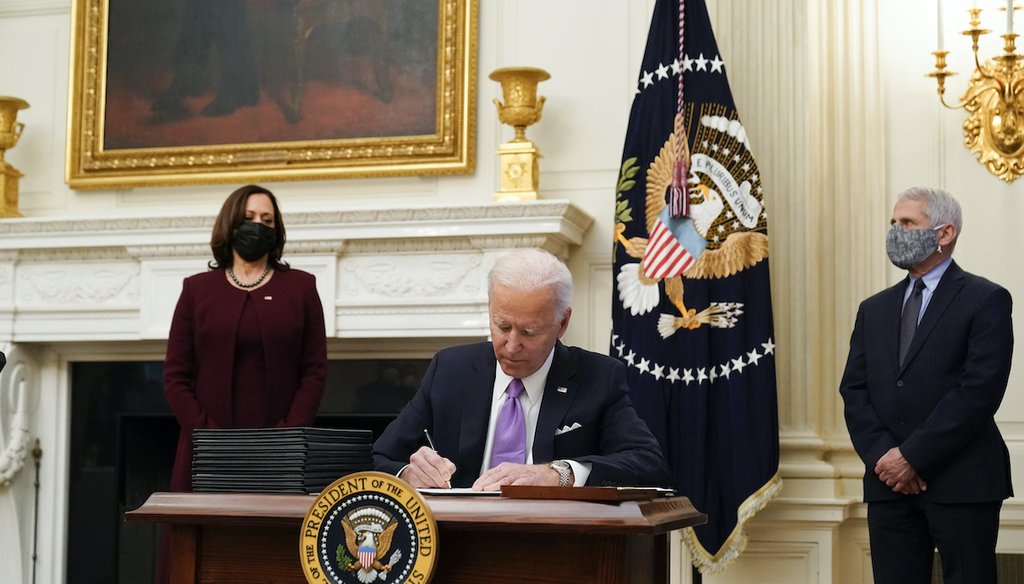Stand up for the facts!
Our only agenda is to publish the truth so you can be an informed participant in democracy.
We need your help.
I would like to contribute

President Joe Biden signs executive orders alongside Vice President Kamala Harris and Dr. Anthony Fauci, director of the National Institute of Allergy and Infectious Diseases, in the White House on Jan. 21, 2021, in Washington. (AP/Brandon)
If Your Time is short
- Although it may seem easy, it’s complicated to overturn rules from earlier administrations.
- There is one tool, however, that Biden and the Democratic Congress could use to undo the policies the Trump administration left behind. The Congressional Review Act allows for the fast-tracking of the repeal of regulations and other executive actions with simple majority votes in both chambers of Congress and no filibuster in the Senate.
- The CRA also has limits. With a few exceptions, it applies to only those Trump administration policies finalized between Aug. 21, 2020, and Jan. 20, 2021. And it’s available for only the first 60 legislative days — those that either the House or Senate is officially working in Washington. That end date will likely be sometime in April.
Undoing many of the policies of his predecessor is one of President Joe Biden’s top priorities. In early February, Biden even got a little defensive about all the executive actions he was taking in his first days in office to halt policies set by President Donald Trump. "I’m not making new law," he said Feb. 2. "I’m eliminating bad policy."
But as easy as it sounds on the campaign hustings or in a 30-second political ad, it’s complicated to overturn rules from earlier administrations. There is one tool, however, that Biden and the Democratic Congress could use to undo the policies the Trump administration left behind. A little-used law called the Congressional Review Act allows a new administration with a like-minded Congress to fast-track the repeal of regulations and other executive actions with simple majority votes in both chambers and no filibuster in the Senate.
So far, though, Congress has made no attempt to use it, and the president has not called for it. And it appears there are no specific plans to do so, at least not on health-related policies.
Time is of the essence when it comes to using the CRA. With a few exceptions, it applies to only those Trump administration policies finalized between Aug. 21, 2020, and Jan. 20, 2021. And it’s available for only the first 60 legislative days — those that either the House or Senate is officially working in Washington — of the new Congress. That end date will likely land sometime in April.
KHN is tracking health regulations, guidance and executive orders implemented during Trump’s term and whether those policies will continue under the Biden administration.
(KHN has put together this interactive tool of significant health policies implemented by the Trump administration using its own authority — executive orders, agency guidance or formal regulations — and is tracking Biden administration and court actions. It will be updated as actions are taken.)
Trump and the GOP-controlled Congress were not shy about using the CRA to eliminate policies implemented by the Obama administration. Between Feb. 14 and May 17, 2017, Congress passed and the president signed rollbacks of 14 regulations, according to the Congressional Research Service. Before 2017, the 1996 law had been used only once — when the new George W. Bush administration and GOP-led Congress repealed a Clinton-era worker safety rule in 2001.
But experts said it’s not surprising that the Democrats haven’t followed that pattern this year.
"The CRA is such a blunt instrument," said Daniel Pérez, a senior policy analyst at George Washington University’s Regulatory Policy Center. "There are other tools at their disposal."
Using the act is also risky. Under its provisions, once a policy is repealed, no administration can issue a "substantially similar" regulation. But how similar is too similar? No one knows, and it’s never been tested.
"It’s kind of a legal gray area," said Pérez.
The Biden administration may well be the one to test that. One regulation repealed by the Republican Congress using the Congressional Review Act in 2017 dealt with the Title X family planning program. The Obama-era rule forbade state health departments from withholding Title X funding as long as organizations were able to provide family planning services. Several states had banned Planned Parenthood affiliates and other clinics that performed abortions from participating in the program. Title X has not, from its inception in 1970, funded abortions, but abortion providers have long participated to provide contraceptive and other health services.
Family planning groups would like to see those state policies blocked once again.
But the failure to use the Congressional Review Act may be about more than just getting organized in time. Many Trump policy changes that Democrats may want to ditch were part of larger regulations that touched a wide variety of subjects and could include policies that Biden’s team wants to keep. But Congress can’t dismiss only part of a rule.
"The nature of health care rule-making is they tend to be omnibus," said Katie Keith, a health policy researcher and law professor at Georgetown University.
For example, a Jan. 19 regulation finalized by the Trump administration cuts funding for Affordable Care Act marketplace operations and codifies changes that would make it easier for states to create health plans that do not include all the protections offered by the ACA. But those changes are embedded within a much larger regulation required each year to keep the health law operating.
Biden administration officials, rather than try to repeal the entire regulation, will likely rewrite just the pieces they disagree with. That will take significant time and resources. That raises another hurdle the White House has encountered as it tries to change health policy. The Senate has yet to confirm a director for the Office of Management and Budget, and new Health and Human Services Secretary Xavier Becerra was sworn in only last week. Both agencies are required for health regulations to proceed.
"My own two cents is this is not the product of a deliberate decision not to use the CRA," said Sara Rosenbaum, a health law and policy professor at George Washington University. "It’s more a problem with the messiness they have run into with starting up the new administration. They don’t know what they want to do with these rules."
And the transition period was especially tumultuous. Both the Biden administration and the new Congress were delayed in getting organized. First, Trump refused to concede the election — which sparked a mob attack on the Capitol. Then, once it was official that Biden had won, the Senate — now evenly split, 50-50 — didn’t change hands to Democratic control until Inauguration Day, when Vice President Kamala Harris became the tie-breaking vote. An agreement on how to run the Senate and committees took even longer to negotiate between the Democrats and Republicans. Plus, before two Democratic challengers swept the Jan. 5 Georgia runoffs, most people thought the Senate would remain in Republican hands, so the CRA would not have been a viable option.
Even when Democrats assumed control of the Senate and White House, the early weeks were crowded with an impeachment trial, efforts to get control of the pandemic response and the covid-19 relief bill that passed earlier this month.
It’s not too late for Congress to turn to the Congressional Review Act. Keith said one possible use would be on a last-minute Trump regulation known as the sunset rule. It requires HHS to review 18,000 of its regulations, and those not reviewed within a set period will automatically end. A group of health and other interest groups, led by Santa Clara County in California, sued to block the rule March 9.
But congressional action could be a cleaner way to end the rule. "That strikes me as something the Democrats would like to see never come back again," said Keith.
Our Sources
Interview with Katie Keith, health policy researcher and law professor at the Georgetown University Center on Health Insurance Reforms
Interview with Sara Rosenbaum, professor of health law and policy at the George Washington University
Interview with Daniel Perez, senior policy analyst at the George Washington University Regulatory Studies Center
Health Affairs, What A Democratic Congress Means For The ACA, Jan. 7, 2021
The Journal of Health Politics, Policy and Law, The Future of the Indispensable Insurer: The Biden Administration and Medicaid, Jan. 22, 2021.
Congressional Research Service, The Congressional Review Act (CRA): Frequently Asked Questions, Jan. 20, 2020
Brookings, How powerful is the Congressional Review Act? April 4, 2017
Other sources included in links in the story.

























